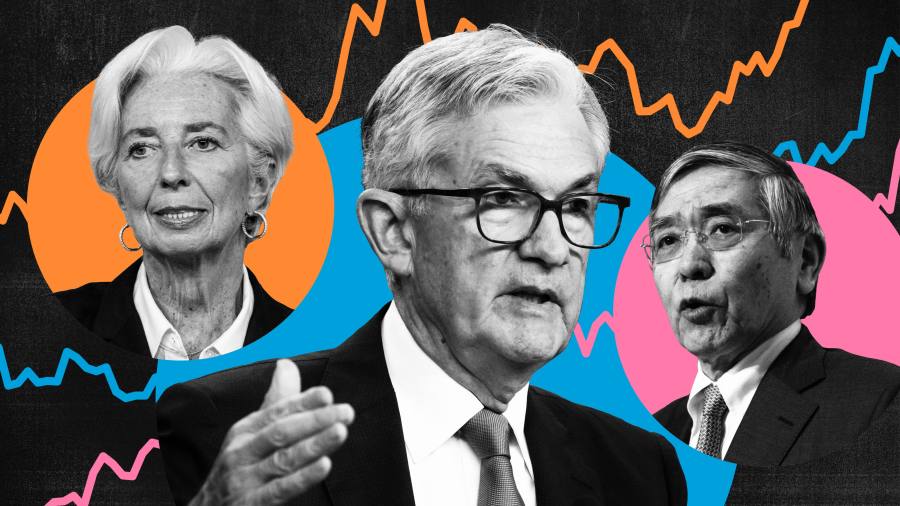With their bills sharpened and talons on display, the world’s central banks fully adopted the posture of the hawk this week. Backed by sharp rises in interest rates and currency intervention, they have used pointed language to advertise their singular aim of defeating the scourge of inflation.
In one of the most sudden shifts in global economic policymaking in decades, central bankers say they have had enough of rapid price rises and insist they are prepared to act to restore price stability, almost at any cost.
But after a week of dramatic announcements from central banks around the world, at least some economists are beginning to ask — are they going too far, too fast?
The US Federal Reserve has been by far the most important actor in this shift of temperament. On Wednesday, it raised its main interest rate by 0.75 percentage points to a range between 3 and 3.25 per cent. At the start of the year, this rate had been close to zero.

The Fed signalled that this was far from the end of its monetary policy tightening, with members of its interest rate-setting committee predicting rates would end 2022 between 4.25 and 4.5 per cent — the highest since the 2008-09 financial crisis.
In the summer, Fed chair Jay Powell talked about higher borrowing costs ending with a “soft landing” for the economy without a recession and a gentle glide down in inflation rates. On Wednesday, he admitted that was unlikely. “We have got to get inflation behind us. I wish there were a painless way to do that,” Powell said.
The Fed’s plan to curtail consumer and business spending in a bid to reduce domestic inflation has been replicated elsewhere, even if the causes of high inflation are different. In Europe, the extraordinary prices of natural gas have sent headline rates of inflation to similar levels as in the US, but core inflation is significantly lower. In emerging economies, declining currency values against the US dollar, which hit a 20-year high this week, have driven import prices higher.
The Swedish Riksbank kicked off the copycat action on Tuesday with a 1 percentage point increase in its interest rate to 1.75 per cent, its biggest interest rate rise in three decades. Switzerland, Saudi Arabia and the UAE also announced a 0.75 percentage point increase each, which for Switzerland meant ending the period of negative rates that started in 2015. The Bank of England on Thursday raised its main rate by 0.5 percentage points to 2.25 per cent, the highest since the financial crisis, with a near promise of further rate rises to come.
Even in Japan, which has long adopted negative interest rates, the authorities felt the need to act to tame inflation. Its finance ministry intervened in currency markets to prop up the yen on Thursday and limit the rise in import prices. It took what it called “decisive action” to address US dollar strength that was pushing the country’s underlying inflation rate to a highly unusual 2.8 per cent rate in August.
Economists at Deutsche Bank noted that for every one central bank around the world that is currently cutting interest rates, there are now 25 banks that are raising rates — a ratio that is way above normal levels and has not been seen since the late 1990s, when many central banks were given independence to set monetary policy.

Nathan Sheets, global head of international economics at Citi and a former US Treasury official, says central banks are “moving so rapidly that as they put these rate hikes in place, there really hasn’t been enough time for them to judge what the feedback effects are on the economy”.
Central bankers have been reluctant to admit they made errors in keeping interest rates too low for too long, pointing out that these assessments are much easier to make with the benefit of hindsight than in real time. But they now want to take action to demonstrate that even if they were tardy in beginning to take action against inflation, they will be sufficiently “forceful”, to use the Bank of England’s word, to bring inflation down.
Powell was clear that the US central bank would not fail on the job. “We will keep at it until we’re confident the job is done,” he said on Wednesday. Sweden’s Riksbank was characteristically blunt in its assessment. “Inflation is too high,” it said. “Monetary policy now needs to be tightened further to bring inflation back to the target.”
The new stance on monetary policy has been developing through 2022 as the inflation problem became more persistent and difficult for central bankers. By the time many gathered at Jackson Hole in August for their premier annual conference, the mood had shifted decisively towards the greater action that is now being played out around the world.

Christian Keller, head of economics research at Barclays Investment Bank, says that “since Jackson Hole, central bankers have decided that they want to err on the side of hawkishness”.
“For the first time in perhaps decades they have become afraid of losing control of the [inflation] process,” says Keller, highlighting how central bankers now say they want to avoid the mistakes of the 1970s. Central banks “are taking decisions that come with much risk and this feels better if everyone else is doing it. The result is a synchronised tightening.”
With the new attitude, markets are pricing that by June next year policy rates will rise to 4.6 per cent in the US, 2.9 per cent in the eurozone and 5.3 per cent in the UK — projections that are between 1.5 and 2 percentage points higher than at the start of August.

By raising interest rates, central bankers are not seeking to lower the peak rates of inflation that have been caused outside the US by soaring gas and food prices, but they are aiming to ensure inflation does not stick at a rate that is uncomfortably higher than their targets. This could happen if companies and employees begin to expect higher inflation, leading to price rises and demands for higher wages.
They are willing to ensure that there is pain in terms of an economic downturn to demonstrate their credibility in hitting their inflation targets.
Sheets says that, having misread inflation last year, central banks would rather overdo it now. They are balancing the prospects of a recession against the risk of a sustained inflationary episode that would undermine their credibility. “On balance they feel . . . that is a risk they have to take.”
An added complication is the models that central banks use — which did not foresee such rapid price rises as the pandemic eased and the war in Ukraine began — are no longer working well in describing economic events.

Ellie Henderson, economist at Investec, worries that “the usual tools and models, which would typically guide such [central bank] analysis, can no longer be relied upon as they are now operating in parameters outside ranges of which they were estimated”.
In this uncharted world, Jennifer McKeown, head of global economics at Capital Economics, believes it is difficult to argue that central banks are going too far.
“While this is the most aggressive tightening cycle for many years, it is also true that inflation is higher than it has been for decades,” she says. “Inflation expectations have risen and labour markets are tight, so central banks are rightly concerned about the potential for second-round effects from energy prices to wages and underlying inflation.”
But an increasing number of economists, led by some big names such as Maurice Obstfeld, former chief economist of the IMF, think central banks are now being excessive in their actions to raise interest rates and that the effect of all this tightening will be a global recession. The World Bank also expressed similar concerns this week.
Antoine Bouvet, an economist at ING, says that “central banks have lost faith in their ability to forecast inflation accurately”, which has led them to focus more on today’s actual rates of inflation.

“Combine this with the fact that they seem to think that the cost of overshooting in their policy tightening is lower than undershooting and you have a recipe for over-tightening,” he explains. “I would characterise this policy choice as almost overshooting by design.”
According to Holger Schmieding, chief economist at investment bank Berenberg, “monetary policy works with a lag, [so] the risk is that the Fed will notice only belatedly that it has gone too far if it now raises rates well beyond 4 per cent”, resulting in unnecessarily long and deep recessions.
But as many economists explain, no one really knows what is too far and not far enough in this environment. Central banks therefore want to ensure they eradicate inflation, allowing them to correct course and lower interest rates later if necessary.
Krishna Guha, vice-chair at Evercore ISI, says there is a “serious risk” that central banks are overdoing the tightening, but he contends the Fed is right to err in the direction of doing too much.
“At the global level, as well as at the US level, it is probably better to overdo it than underdo it and risk a 1970s redux,” says Guha. “But that of course only makes the outcome of overdoing it more likely.”



